Japanese Linen Cross Back Pinafore Apron Pattern
This Japanese linen cross back pinafore apron pattern is my favorite apron pattern ever.
Ever since I first discovered these Japanese style aprons, I’ve been in love with them.
I knew I had to make one for myself!
This free pinafore apron pattern is the result of my trial and error, and it was worth all the trouble!
Japanese Pinafore Apron Pattern
Sometimes called the Japanese utility apron, this style of pinafore apron lends itself to a variety of situations.
It’s perfect for working in the garden, cooking in the kitchen, and any homemaking task.
What is a Pinafore Apron?
One of the things I love best about the pinafore apron is that it doesn’t have any ties or fasteners.
You just slip it on over your head and it’s ready to wear!
This apron would be so beautiful made out of 100% linen, but I used a linen/cotton blend, as it’s more affordable. It’s still beautiful!
Supplies Needed to Make This Pinafore Apron Pattern
This post contains affiliate links, which means I may make a small commission at no extra cost to you. Read my disclosure here.
Here are the supplies you’ll need to make this pinafore apron pattern.
- 2 yards linen fabric (I used this fabric for my first apron and this fabric for the second one)
- measuring tape
- sewing gauge
- scissors
- matching thread
- sewing pins
- magnetic pincushion (optional—I’ve loved mine for 10 years!)
- sewing machine (this one is similar to mine but this sewing machine is another good choice)
Watch the Pinafore Apron Pattern Video
How to Make a Japanese Linen Cross Back Apron
This DIY apron pattern uses some basic measurements and basic stitches. But I wouldn’t necessarily recommend it for beginners.
Even though it’s a pretty basic concept, if you’re not already familiar with sewing terms and techniques, some of the instructions might seem confusing.
That said, if you’re an ambitious beginner willing to try something new, go for it!
Before getting started, go ahead and pre-wash your fabric to avoid shrinkage later. I also iron my fabric if it’s very wrinkled after coming out of the dryer. This makes it easier to work with.
Take Your Measurements
First, you’ll want to take some basic measurements.
- Measure right above your bust and add 5-6 inches to this measurement for wearing ease after sewing.
- To find the apron length, put the measuring tape above your bust (where you measured originally) and let it hang down, and decide how long you’d like your apron to be. Add 3″ to this measurement for the hem.
As an example, here are my measurements. My above-bust measurement was 38″, and I added 5″, which brought my width measurement to 43″.
For the length, I decided on 30″ + 3″ which gave me 33″. So I cut my main apron body piece 43″ x 33″.
Cut Out Your Apron Pieces
Here’s a list of all the pieces you’ll need to cut out for your apron.
Cut One Apron Body Piece using the measurements you took above. My apron body piece was 43″ wide x 33″ long.
Cut 1 Apron Facing: Cut a strip of fabric for your apron facing. Make it the width of your apron and 5″ long. My apron facing (using the above measurements) was 43″ wide x 5″ long.
Cut Two Straps: 20″ x 7″ (straps are 20″ long by 7″ wide)
Cut 2 Pockets: 11″ x 8″ (pockets are 11″ long by 8″ wide)
How to Sew a Japanese Pinafore Apron
There are a lot of steps to making this apron, as I’ve tried to be as detailed as possible. Don’t be intimidated by all the steps. Just take them one at a time!
I highly recommend checking out the video that I made to go along with this pattern. (Find the video above.) I didn’t get all the steps filmed, but I still think it’s helpful, especially when it comes to attaching the straps.
1. On the apron body, turn hem up 1/2″ and press. Turn up another 2″ and press well. Pin hem in place and sew along folded edge. Press hem.
2. Turn under apron sides 1/2″ and press. Then fold over again 1/2″ and press. Don’t sew this hem yet. Set apron body aside.
3. On apron facing piece, turn under 1/2″ on one long edge and press. Set aside.
Sewing and Attaching the Straps
This is the part where watching the video (above) would be helpful. It might help give you a visual of how the cross-back goes together.
4. Sew the straps. Fold one strap piece in half lengthwise (right sides together if your fabric has a printed side) and sew with a 1/2″ seam. Trim seam to 1/4″. Turn fabric right side out (using a large safety pin attached to one end) and press seam (I leave the seam on the edge of the strap). Repeat these steps with the other strap.
5. Lay apron body piece right side up. Take one strap and pin 1″ away from the raw edge of the apron body at top left side of fabric. Repeat with other strap so both are pinned on.
6. Fold apron in half and mark center front with a pin at the top of the apron. Using a measuring tape, mark about 7″ at center front of apron. Put a pin at the beginning and end of the 7″ so your straps will be about 7″ apart.
7. Lay apron body face up in front of you. Take the strap on the right and cross it over, bringing it to the front opposite side and pin. Repeat with the other strap, crossing it over and pinning it to the front. The apron straps should be about 7″ apart in the center front. (Please see the example in the video, as it’s easier to show this than to explain it in writing.)
8. Baste straps in place using a 1/4″ seam allowance.
9. Try the apron on and make sure the strap placement is correct and neither strap is twisted.
Sew on the Apron Facing
10. Lay apron body right side up. Lay apron facing over the top of the apron body (right sides together) and pin in place. Stitch apron facing to apron body, using a 1/2″ seam allowance. Trim seam to 1/4″. On inside, press seam up toward top of apron.
11. Turn apron facing to inside of apron, and press apron facing down, making sure the edge you turned under earlier is still nicely pressed.
12. Top stitch along the top edge of the apron.
13. Sew down the folded under edge (the bottom edge) of apron facing close to the edge of the fold.
14. Hem apron sides by sewing along previously folded 1″ (that you folded under and pressed in an earlier step).
Make and Sew on Apron Pockets
15. Make pockets. Turn under 1/2″ on pocket top.
Fold again at 1 1/2″ with right sides together.
Stitch top down with a 1/2″ seam allowance.
16. Trim corners diagonally and turn pocket right side out.
Press sides of pocket under 1/2″ and then fold bottom up 1/2″ and press. Top stitch top of pocket fold.
Repeat steps for other pocket.
17. Try apron on and decide where to put the pockets. I outline where I want the pockets to be with pins. I put mine about 11″ from the bottom and about 8 1/2″ from the sides of the apron.
18. Pin pockets to apron. Stitch pockets down around each side and bottom, leaving the top edge open.
Finishing Your Pinafore Apron
19. Cut off all loose threads and press apron again. You’re done!
Shop the Supplies for This Project
- 2 yards linen fabric (I used this fabric for my first apron and this fabric for the second one)
- measuring tape
- sewing gauge
- scissors
- matching thread
- sewing pins
- magnetic pincushion (optional—I’ve loved mine for 10 years!)
- sewing machine (this one is similar to mine, and this one is another good option)
Pin This Post for Later
This post contains affiliate links, which means I make a small commission at no extra cost to you. Read my disclosure here. Sharing here.

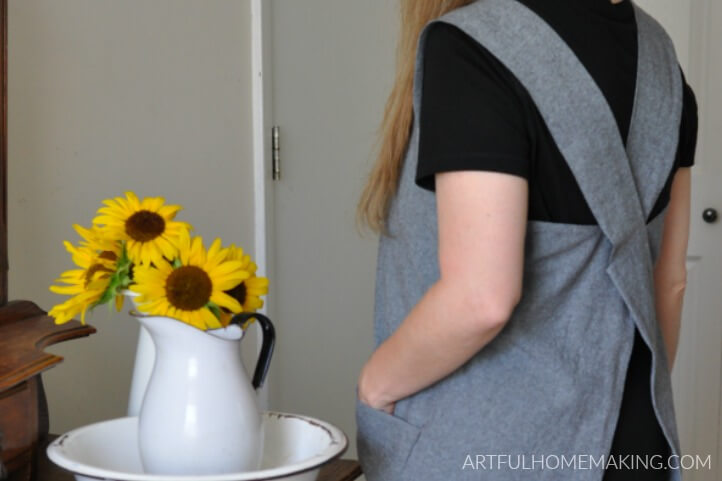
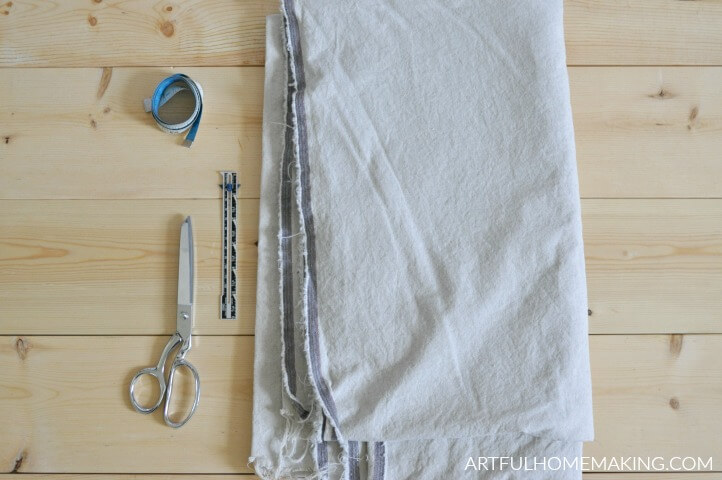
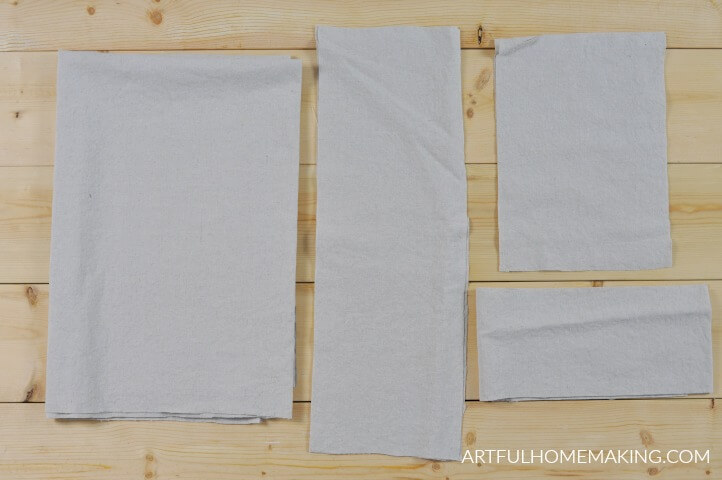
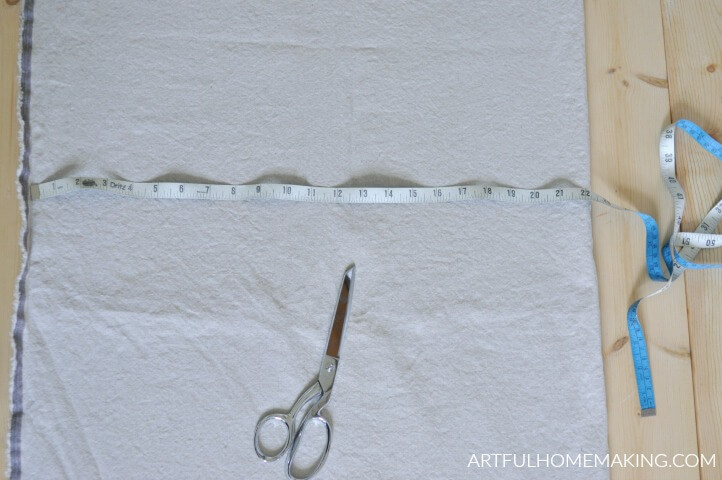
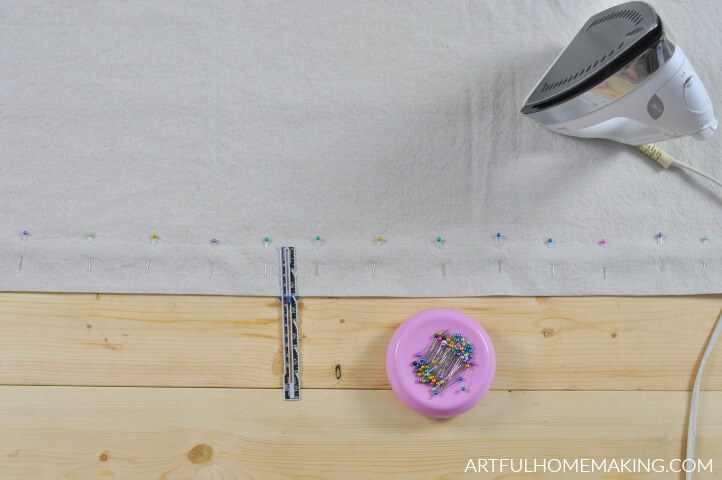
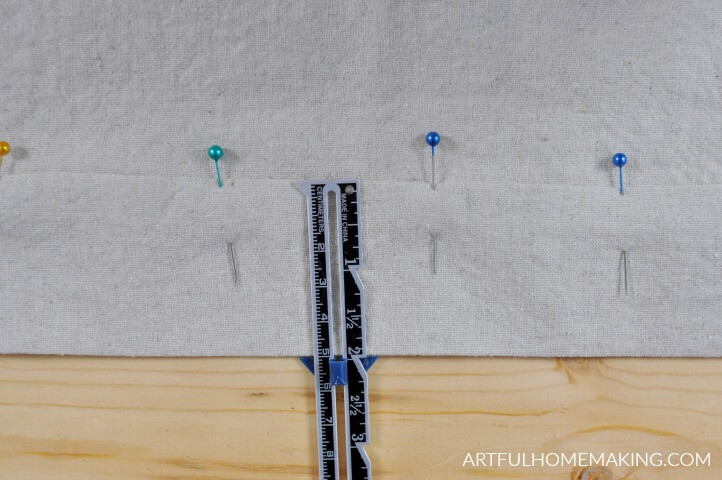
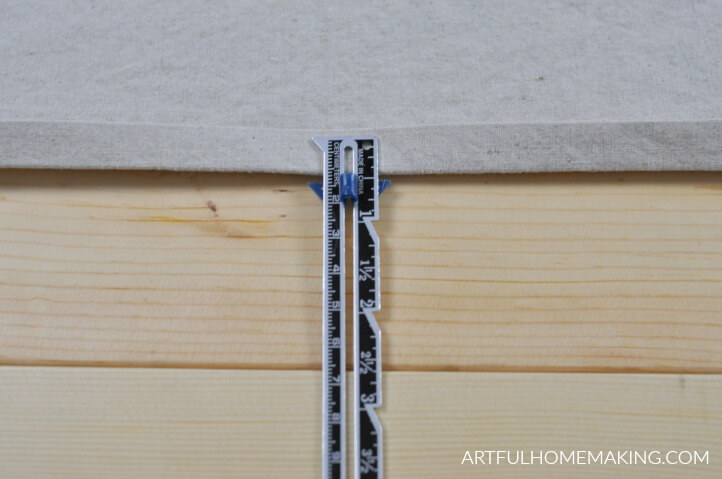
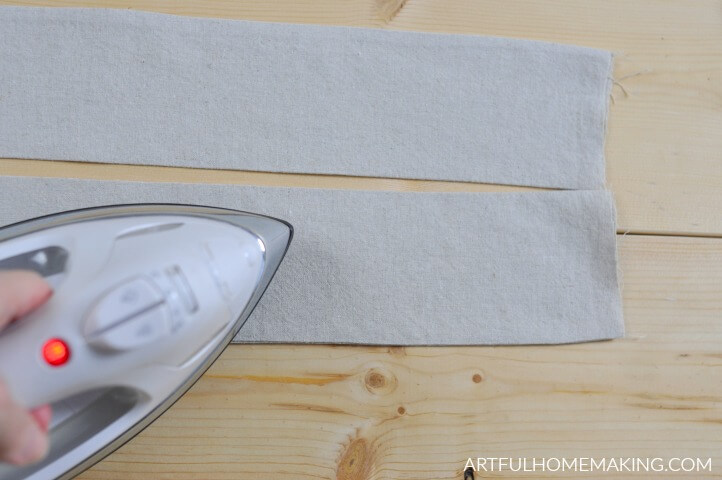
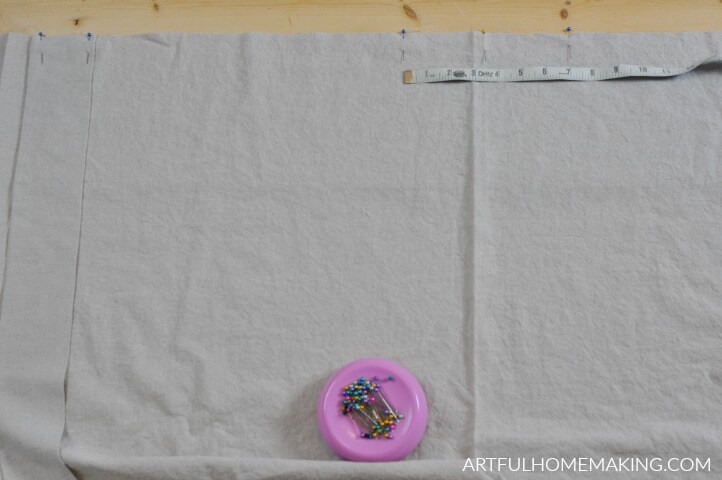
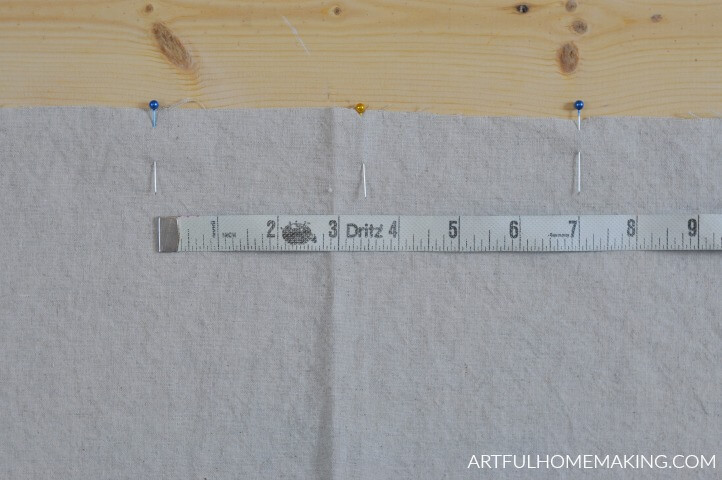
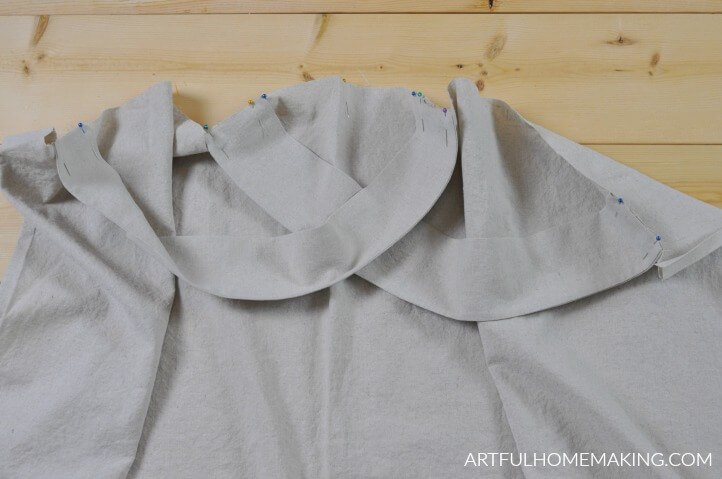
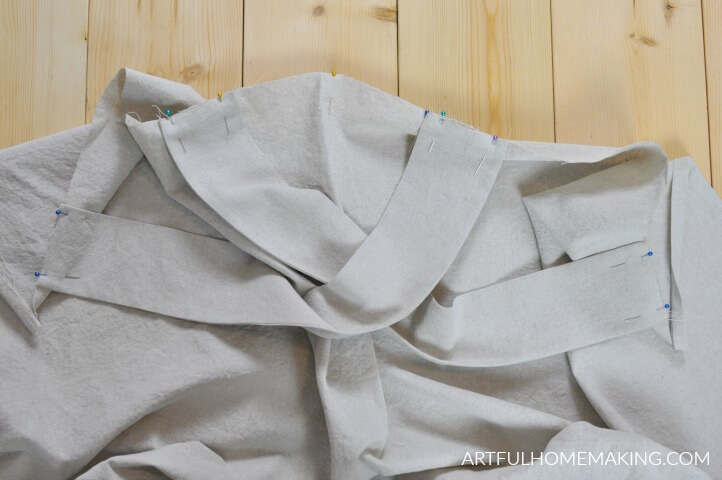
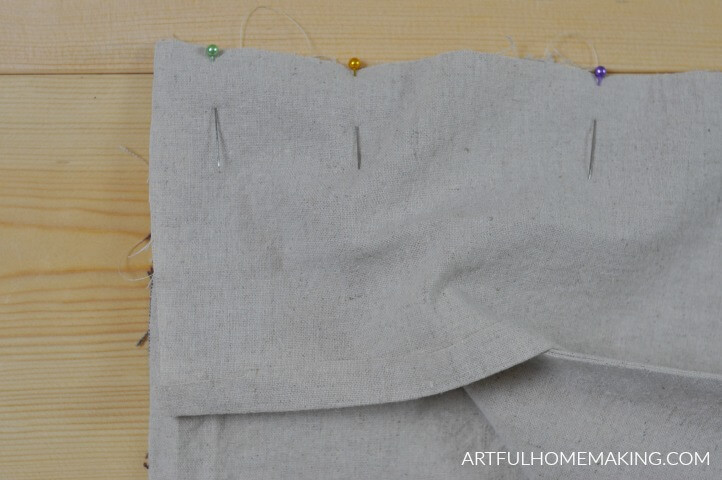
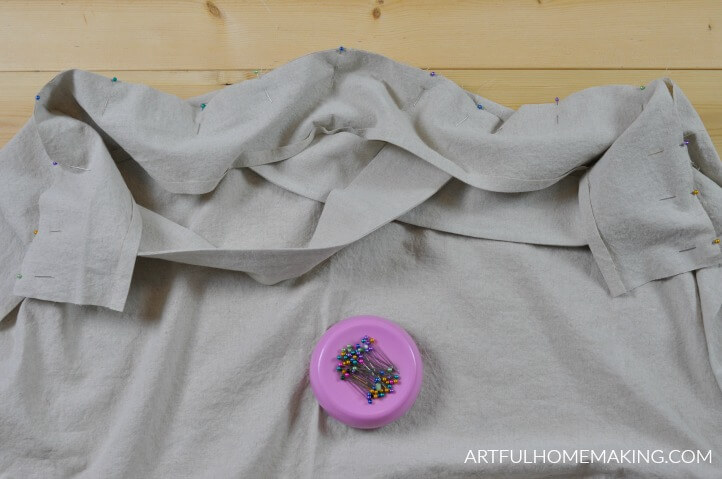
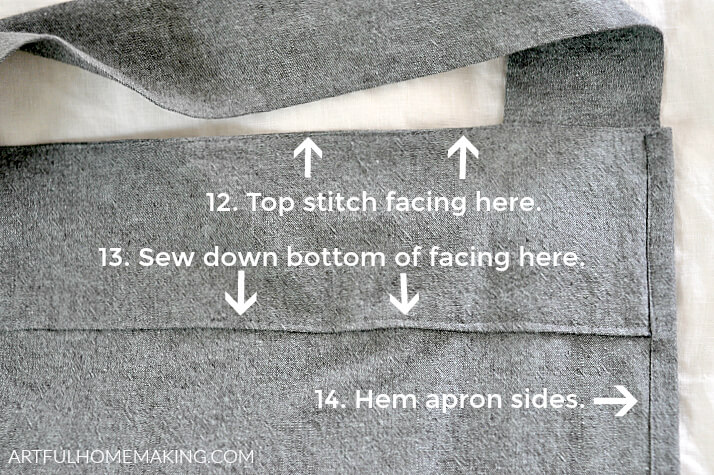
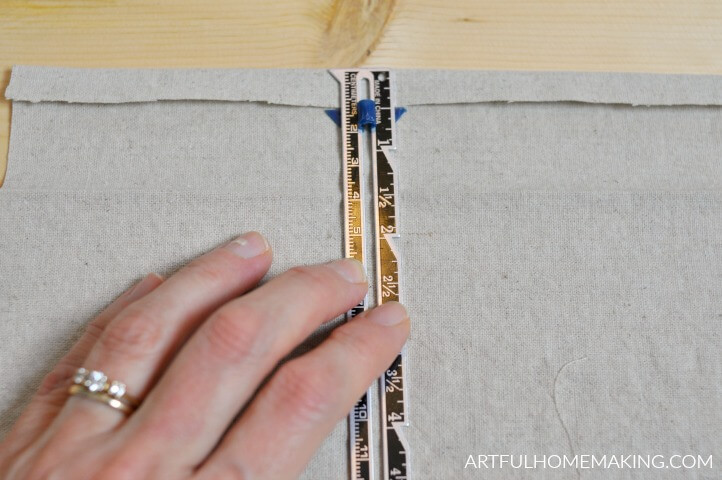
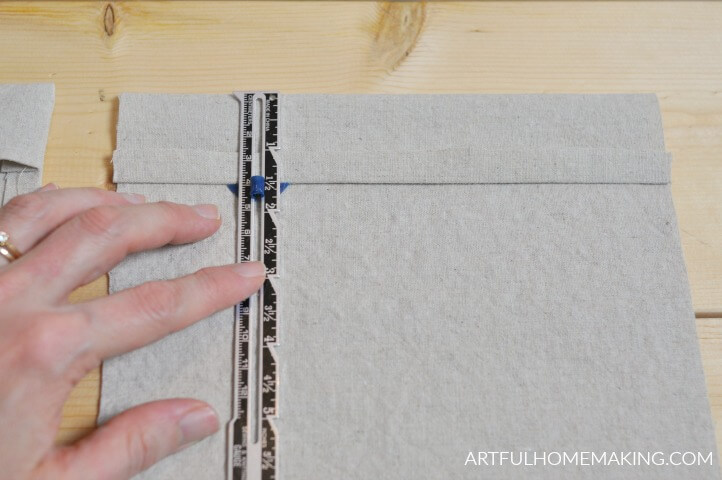
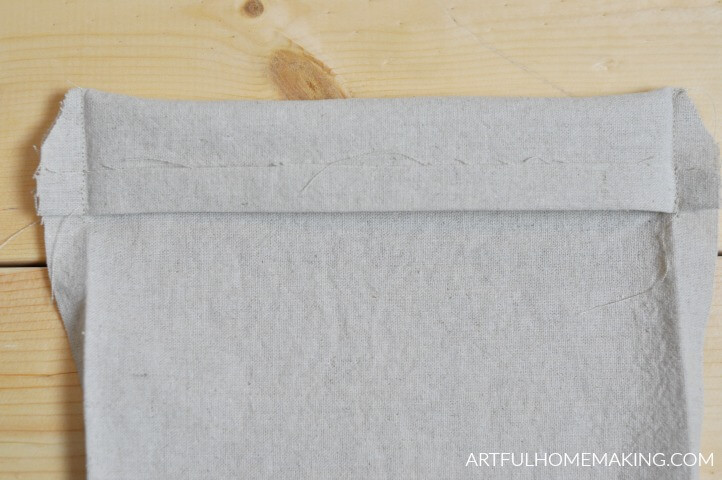
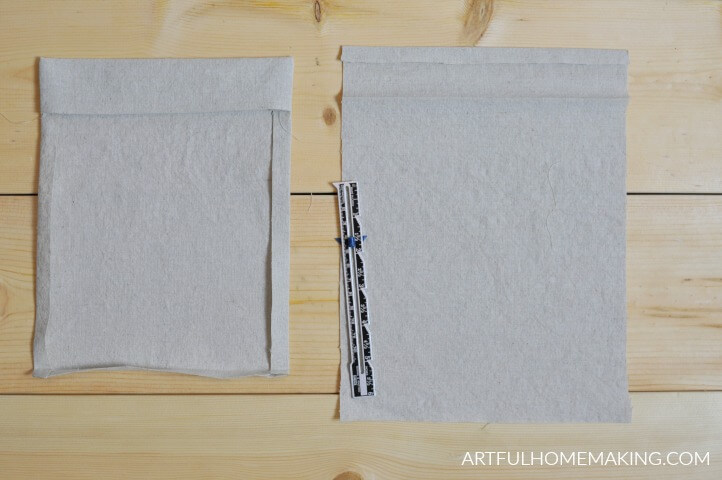
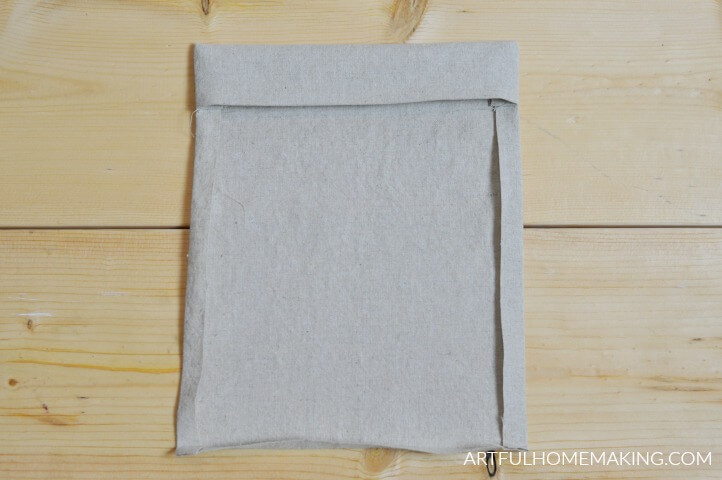
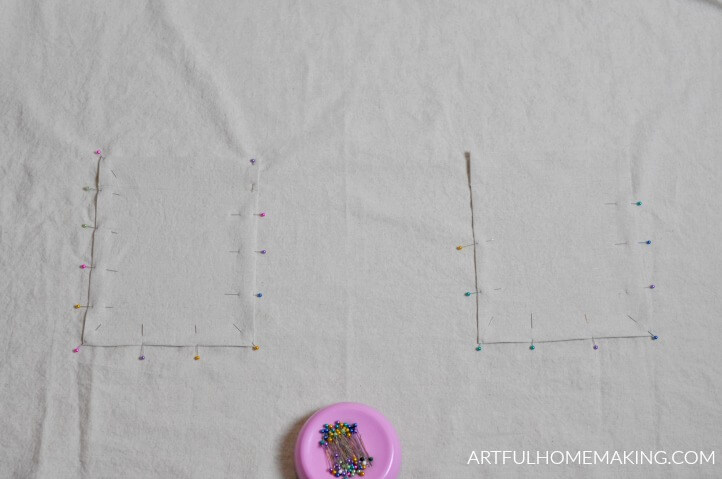
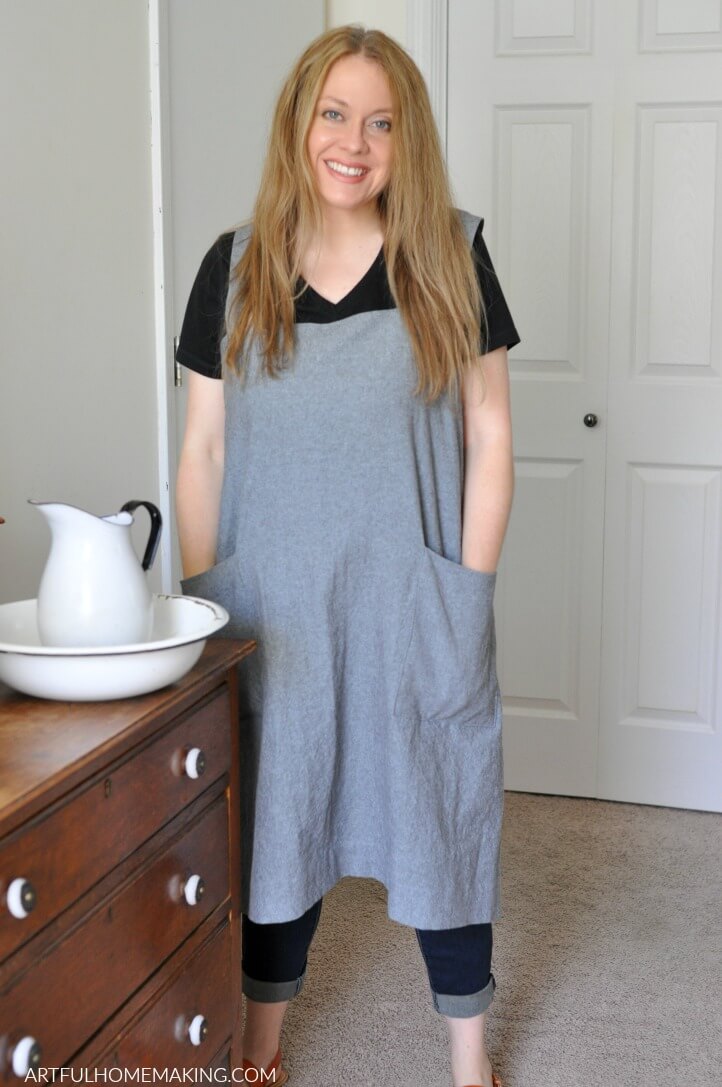
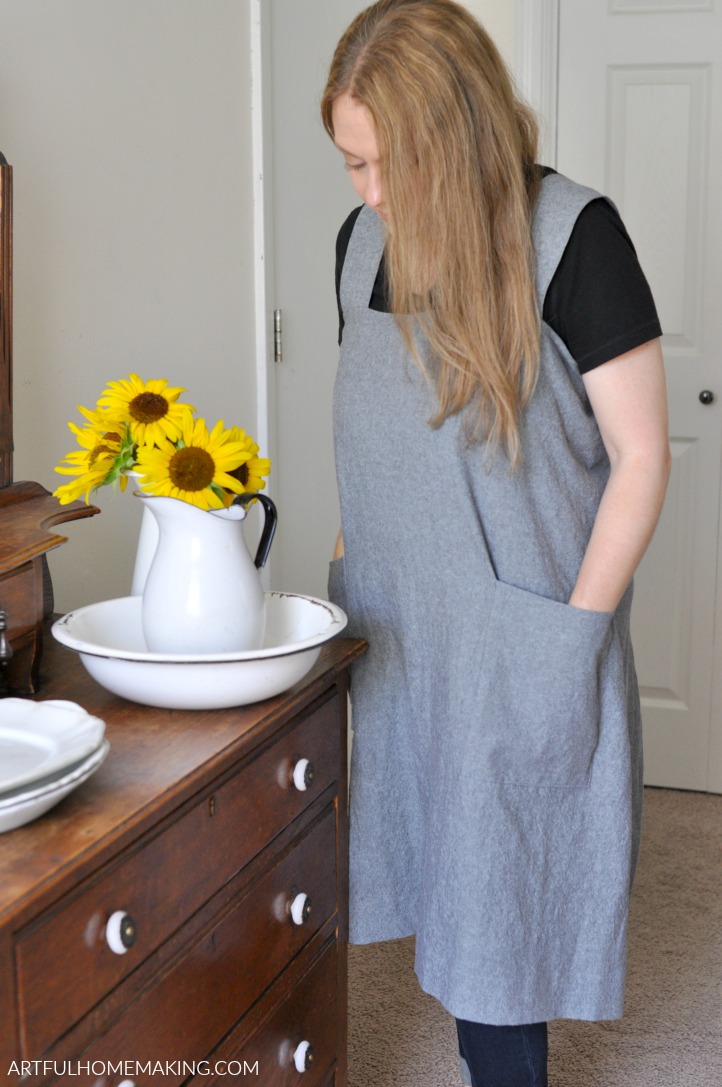
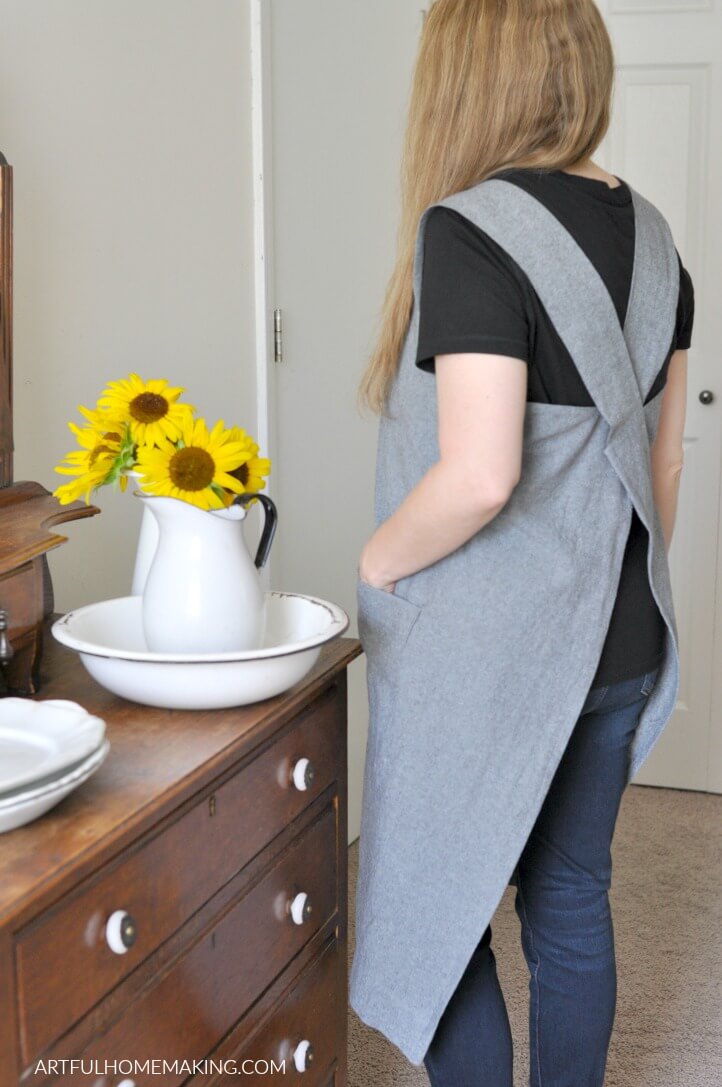
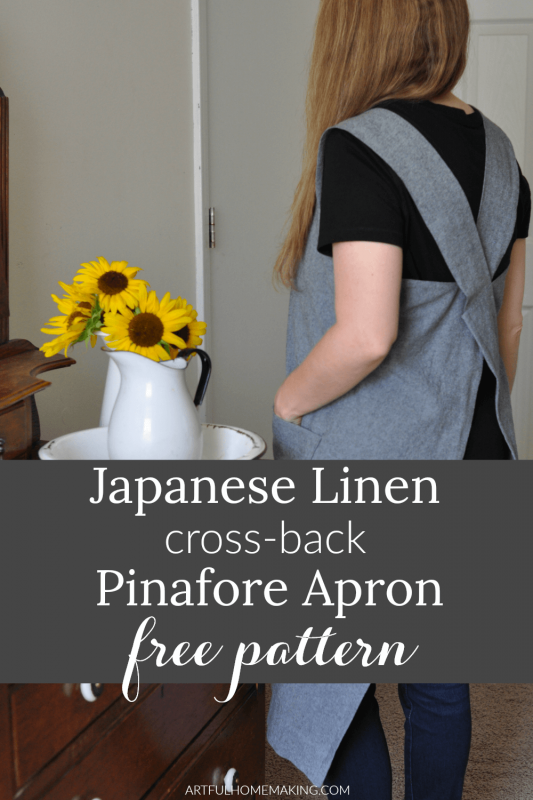
Does this type of fabric hold up to cooking/stains/drips? How does it come out in the wash? Does it need ironing before every use?
The fabric I used for my aprons is of a thicker weight, so it has held up very well. I machine wash them and then put them in the dryer for just a few minutes to get any wrinkles out, and then I hang them to dry on a clothing rack.
Thank you for the pinafore apron tutorial. You did a great job! Your first? Amazing.
I’ve though many times about making tutorials but I always leave it to those if you making the plunge.
Your pattern and direction are to the point, simple, and easy to understand, at least to those of us with sewing experience.
Your apron seems classic.
Thank you!
Just made this today in about an hour! I love it. It was very easy, thank you.
Yay! I’m so happy to hear that! And thanks so much for the positive feedback!
Facing. You said cur the facing according to width of your size. Example mine is 42inch x5
The two sides of the main body apron have in put under 1/2×2 (2x) so that would leave you two inches shorts for the facing.
My question is do you overlap them?
The facing will be a bit wider after the sides of the apron body have been folded in and pressed. Before pinning and sewing the facing piece down to the body piece, you open up that folded edge so the two pieces (the apron facing and the body piece) are the same width. Then, after you’ve sewed the facing to the body piece, you fold that previously folded and pressed apron side piece back over the facing (steps 10-14). Hope that helps!
Thank you so much for posting this! I am a novice and have never made any clothing before. I do love to sew when I have the chance but found your pattern and wanted to give it a shot. With your directions it was so simple! Thanks so much! The finished product is for my sister and I hope she loves it as much as I do. It was so much fun to make!
Yay! I’m so glad to hear it was a success! I hope your sister loves her new apron!
Hi Joy,
Thank you so much for this. I love the pattern and plan to try it but am a bit confused about the facing. I couldn’t work out whether it is folded over to the back of the apron – in which case aren’t the straps in the way – or goes along the front.
Also what does baste mean when sewing on the straps?
Jenny
Hi Jenny! I know this pattern can be confusing. First, to baste means to use a very loose stitch that can be easily removed. So, you baste the straps on when you’re deciding on strap placement. That way, if you get them in the wrong place (or desire to move them), you can easily remove the basting and relocate the straps. If they’re where you want them, you can just leave that stitching in place when you stitch the facing in place.
So, when you attach the facing, the straps are already basted in place. You lay the apron right side up, and move the straps so they aren’t in the way. There are two pictures under step 10 that might help illustrate this. Lay the facing on top of the straps and the apron, and then pin it all down (see the photos under step 10). Then, stitch the facing to the apron front. Then trim the seam to 1/4″ (which makes it less bulky) and then turn the apron facing over to the inside of the apron. So the facing ends up being folded over to the inside (the back) of the apron, after you’ve attached it to the front.
Hope that helps!
Beginner question. When you say measure above the bust area, do you mean around or just arm pit to arm pit. Also, does this account for those who are fuller? Is the measurement done the same as bust measurement for under garments?
I’m so sorry I’m just now seeing your question, Nichole! Yes, you measure around the upper bust area, all the way around. So, put the measuring tape under your armpits, and let it slide down a little to the upper bust area (just above where the cleavage starts, to be more specific!). So, this will be a different number than your full bust measurement. I am fuller in this area (38″ at the upper bust area, about 39″ – 40″ for the actual bust measurement). So, yes, this will help the apron fit better. But it is open in the back, which allows for some ease in the apron. Hope that helps!
Thank you so much, Joy! I loved your post, and the way you explain things, so didactic, so altruistic. I made the apron, the very one I was looking for.
Peace and good!
Thank you! I’m so happy to hear about your apron!
I like this apron because it doesn’t have a strap that pulls on your neck. Thank you for sharing at Party In Your PJ’s.
Thanks, Ann!
How do you adjust the strap lengths to fit your size apron?
Hi Diane! For most sizes, the 20″ strap length should be fine. If you want to adjust it, that might require some trial and error. If you feel they need to be longer, you could just add an inch or two (or more) to the standard 20″ strap length. If you feel they need to be shorter, just subtract an inch or two.
Whenever I’m altering a pattern, I first try it out of some inexpensive fabric I don’t really care much about. I would cut out the apron body piece (using the inexpensive trial fabric) and then cut out two straps in the measurement you think would fit best. Pin the straps to the apron body, and baste to the apron, as shown in steps 5-9. Try the apron on, and see if you like the length of the straps. Then you’ll know if they need to be adjusted, longer or shorter. I hope that helps!
Hi Joy,
Great work here! Is it just me or is putting these on and off sometimes a confusing act of which strap goes on and off? I find that with other ones I end up sometimes taking the wrong one off first and then having to almost step out of the apron. Have you found this to be the case, or any tips on this? Maybe sew the straps together where they overlap in the back so its more of a “pull on / pull off” situation? Cheers!
Thank you! Yes, the straps can be confusing. You could certainly try sewing the straps together to see if that helps.
Is there an actual pattern? Or do we just use the measurements? What does apron facing mean? it looks the same? I am definitely a beginner and have just started branching out.
Hi Jennifer! You’re correct, it’s just the measurements. The apron facing is just a small piece of fabric that goes at the top and just finishes the edges at the top of the apron. This tutorial may be a bit of a challenge if you’re just starting out, but you’re welcome to try it! I keep planning to share a more beginner-level apron pattern, just haven’t had a chance yet. 🙂
been looking for this pattern for ages I hope to make a selection for my self
So glad it was helpful, Tracey!
saw your video on YouTube! great tutorial! been looking to make one of these! will def be making one now!..
Thank you, Lynda!
I’m going to try this! I would like to start learning to make some basic clothes for myself.
That’s great! Sewing is such a satisfying skill. It’s fun to know you made it yourself!
I looked at several suggestions for the Japanese apron and wish I had found your vidoe first. For someone who already sews your instructions were perfect. I will use this for teaching sewing in my family and to make the apron my daughter asked for, who manages a local coffee shop.
So glad it was helpful, Kathryn!